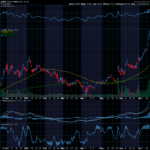by Don Wellenreiter
For many newcomers, their first type of trading is paper trading. This is where you trade the market as if it were real, except that orders are not actually entered, so you won’t experience actual loses or gains. This really is a good way for someone to learn some of the basics of trading without facing large loss due to inexperience. Using a charting service or getting the information from the internet, the new trader can track a commodity and plan his strategy for trading. There are websites that offer trading contests with artificial accounts. This is where you can test a trend following system, a break out system, or a counter-trend program on as many commodities as you wish, since you are not limited by your margin requirement. While you could paper trade numerous commodities at one time, I do not believe that there are many traders out there that can effectively trade more than a handful of markets at once. Find a market(s) you understand and stick with it.
To truly make paper trading work, you must be honest with yourself. Without the benefit of hindsight you must enter and exit your trades. Paper trading does not give you the very real problem of “slippage” which can and will occur in virtually any market. You must take into consideration all commissions and feels that are involved in executing your trades. The generally accepted figure to use of slippage and commissions is $100. You may be thinking that since you can trade at a discount firm for $35 a round turn that $100 is too much. Remember, $35 is just your commission. It is not unusual for commodity futures to slip into a “fast market” condition only to have your stop filled at a much lower level.

Although some traders may dispute this, I believe that since the Mini S&P is just like paper trading, except that real money is made or lost. For any of you who may have traded the “old S&P” with its higher tick value, you know what I mean. A 1000 point move in the Mini is worth $500; still a large enough sum, but nothing compared to the heart stopping old value of $5000 of days gone by. After you have paper traded the S&P and you are beginning to feel comfortable with your system, ease into the market by trading the Mini. Keep in mind that just because the dollar value of the Mini is only 20% of the regular S&P, money management is still very important.
Paper Trading Versus Reality
The biggest knock about paper trading is that you don’t have the psychological gut check you get when you are in a losing trade. Everyone says that they would do this or that during a losing trade, which they may or may not do. Nothing can compare to the actual feeling you get when real money, you money, is on the line. It is amazing how many “paper trading millionaires” there are out there, but yet most of them end up losing real money once the game counts. The other problem Is that it can give a trader a false sense of security. The difference is comparable to fighter pilots practicing in a simulator versus actual combat fighting. In a simulator you can mess up and still watch your favorite television show that night. Screw up in battle and you’re dead.










Recent Comments